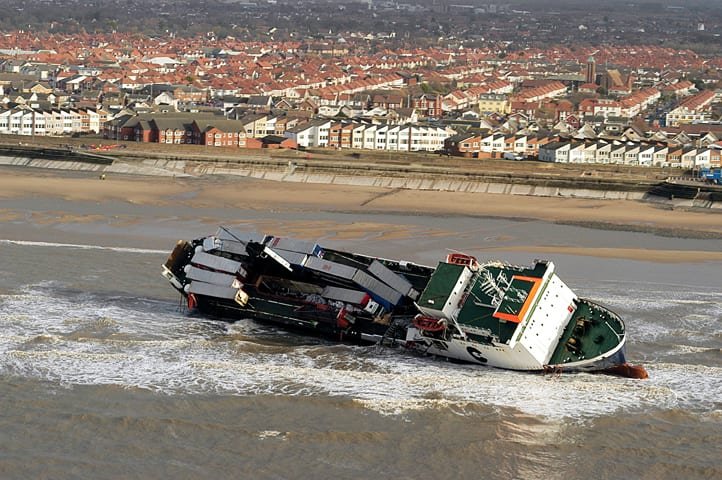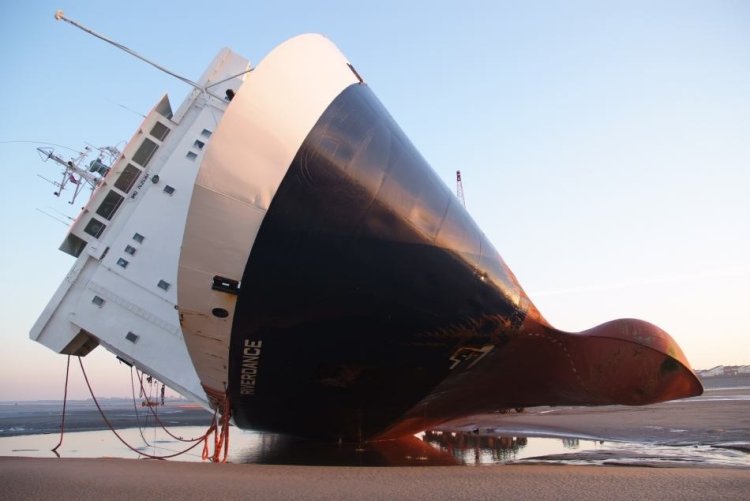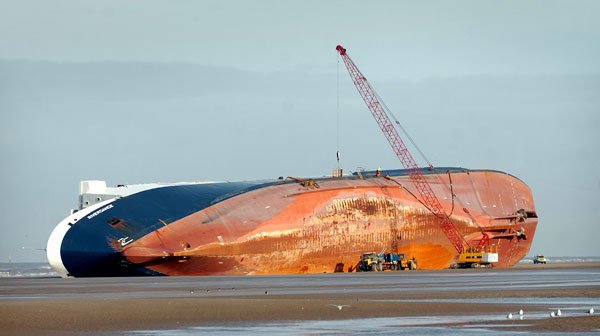The Riverdance Final Voyage into glorious Wreck
The grounding of the Riverdance ferry on Cleveleys Beach in January 2008 turned from a maritime disaster into an unexpected tourist attraction. Despite efforts to salvage the vessel, continuous storms led to its dismantling on site. The incident drew over 100,000 visitors, boosting local businesses and creating a lasting impact on the community.
On January 31, 2008, the M/V Riverdance, a 6,041-gross-ton Ro-Ro cargo ship operated by Seatruck Ferries, faced a formidable challenge. During its routine crossing from Warrenpoint, Northern Ireland, to Heysham, Lancashire, the vessel encountered an extraordinary force of nature that would ultimately lead to its demise and create an unexpected tourist attraction.
The Incident
The Riverdance set sail from Warrenpoint at 11:30 a.m., carrying 52 trailers, one truck, and one private car. As it neared its destination in the early evening, the ship was struck by a freak wave in heavy seas off Lune Deep, causing a dramatic shift in the cargo and resulting in a severe list to port. This list, at times exceeding 60 degrees, rendered the vessel uncontrollable and set it on a collision course with the coast.
Despite the efforts of the captain and crew to stabilize the ship, conditions continued to deteriorate. The port main engine tripped due to the excessive list, leaving the vessel underpowered. The crew's attempts to redistribute ballast and restart the engines were unsuccessful, and the Riverdance drifted inexorably towards the shore. The ship eventually grounded on Cleveleys Beach near Blackpool, Lancashire, at around 8:00 p.m. that evening.
Rescue Operations
As the situation worsened, the captain called for helicopter assistance at approximately 7:30 p.m. Four passengers and 19 crew members were on board at the time. The Royal Air Force quickly dispatched helicopters to the scene, battling 60 mph winds and treacherous conditions to evacuate the passengers and most of the crew. The remaining crew, including the captain, made final preparations to secure the vessel before abandoning ship as the tide approached high water around 5:00 a.m. on February 1, 2008.
The rescue operation was fraught with challenges, including high seas, strong winds, and darkness. Despite these obstacles, the RAF helicopters successfully evacuated all individuals without injury, a testament to the skill and bravery of the rescue teams involved.
Salvage Attempts
In the days following the grounding, poor weather hampered salvage efforts. A Rotterdam-based salvage team arrived on site, but continuous storms and the ship's deteriorating condition thwarted their attempts to refloat the vessel. Efforts included reducing the list and pumping out fuel to mitigate environmental damage. However, the ship's structural integrity had been compromised by the severe list and the pounding surf.
Despite initial hopes to refloat the vessel, severe weather conditions and the ship’s deteriorating condition ultimately led to the decision to scrap it on-site. The vessel was declared a constructive total loss, meaning the cost to repair the ship exceeded its value. The final dismantling of the Riverdance took place on the beach, handled by Hancock's Contractors from Heysham. This operation marked the end of a months-long effort to salvage the ship, which had captivated public attention and drawn significant media coverage.
A Tourist Attraction Emerges
Remarkably, the grounded Riverdance quickly transformed into a temporary tourist attraction. Over 100,000 visitors flocked to the site, drawn by the sight of the beached vessel. This influx of tourists provided a significant boost to local businesses, particularly beneficial during the typically slow winter months. The ship's unexpected popularity led to a change in plans; rather than removing the wreck immediately, it was decided to leave it in place for an extended period.
Local entrepreneurs capitalized on the sudden tourist interest, selling memorabilia and setting up viewing platforms. The unusual sight of the large vessel stranded on the beach captured the public imagination, making it a must-see destination for many. Local cafes, restaurants, and shops saw increased foot traffic, turning the shipwreck into a surprising economic boon for the area.
Final Dismantling
Ultimately, the decision was made to dismantle the Riverdance on site. Hancock's Contractors from Heysham were tasked with the delicate operation of breaking up the ship. The dismantling process, though necessary, marked the end of an era for the local community, which had grown accustomed to the ship's presence and the economic benefits it brought. The dismantling process was conducted carefully to ensure minimal environmental impact, and the remains of the ship were removed piece by piece.
Environmental Concerns and Efforts
Environmental concerns were a significant consideration throughout the salvage and dismantling process. The Riverdance carried fuel and other potentially hazardous materials that posed a risk to the local ecosystem. Salvage teams prioritized pumping out the vessel's fuel to prevent spills, and continuous monitoring was conducted to detect any leaks or contamination.
Efforts to minimize environmental damage included using absorbent booms and skimmers to manage any spilled fuel and ensuring that debris from the dismantling process was properly contained and disposed of. These measures helped protect the coastal environment, preserving the area for future generations.
Lessons Learned
The Riverdance incident highlighted several critical safety and operational issues. The vessel's severe list and subsequent grounding were exacerbated by the lack of accurate stability information and inadequate guidance for handling such extreme weather conditions. The ship's classification society, Det Norske Veritas, and the vessel's owners, Seatruck Ferries, were prompted to review and improve their safety protocols to prevent similar incidents in the future.
The incident underscored the importance of robust safety measures, including accurate cargo securing practices, comprehensive stability data, and effective emergency response plans. The maritime industry took note of these lessons, leading to improved regulations and practices to enhance the safety of Ro-Ro vessels and their crews.
Conclusion

The story of the Riverdance is one of both disaster and opportunity. While the ship's grounding was a significant maritime incident, it also brought unexpected benefits to the local community, demonstrating resilience in the face of adversity. The incident serves as a poignant reminder of the power of nature and the importance of preparedness and adaptability in maritime operations. The Riverdance, now dismantled, remains a vivid memory for those who witnessed its final voyage and the transformation it sparked on Cleveleys Beach.
From a tragic accident to an unexpected tourist attraction, the Riverdance's journey is a testament to human resilience and ingenuity. The local community's ability to turn a potentially devastating event into a positive economic impact highlights the strength and adaptability of people when faced with unforeseen challenges.
What's Your Reaction?





















